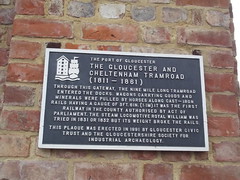The Gloucester and Cheltenham Tramroad
(1811-1861)
thing and horse-drawn railway (1811-1861)
Commemorated on 1 plaque
The Port of Gloucester The Gloucester and Cheltenham Tramroad (1811 - 1861) Through this gateway, the nine mile long tramroad entered the docks. Wagons carrying goods and minerals were pulled by horses along cast - iron rails having a gauge of 3ft. 6in. (1.1M). It was the first railway in the country authorised by Act of Parliament. The steam locomotive Royal William was tried in 1831 or 1832 but its weight broke the rails. This plaque was erected in 1991 by Gloucester Civic Trust and the Gloucestershire Society for Industrial Archaeology.
Gloucester Docks, Gloucester, United Kingdom where it was (1811-1861)
